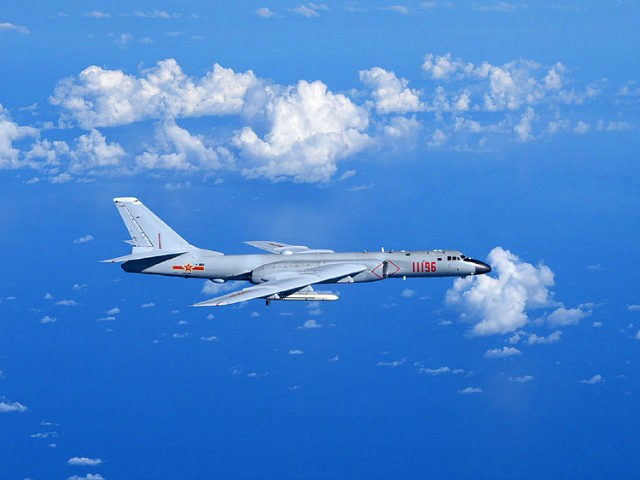China reportedly landed one of its H-6K heavy bombers on Woody Island in the Paracels late last week, increasing concerns about Chinese militarization of disputed islands in the South China Sea, prompting a complaint and “appropriate diplomatic action” from the Philippines.
The Chinese military announced the first landing of a heavy bomber on a disputed island on Friday, stating that several H-6K bombers were launched from an airbase in southern China for “a simulated strike against sea targets before landing on an island in the South China Sea.”
The Chinese statement did not specify where the bombers landed, but military experts quoted in various international publications were confident the landing occurred on Woody Island, which holds China’s largest airbase in the Paracels. China has also built several military-grade airfields on disputed islets in the Spratly island chain, some of which were substantially built up by Chinese engineers to accommodate the airstrips. H-6K bombers have sufficient range to cover the entire South China Sea from Woody Island.
That strike range also includes all of the Philippines, as the Asia Maritime Transparency Initiative of the Center for Strategic Studies (CSIS) pointed out in an analysis quoted by the Japan Times:
“Nearly all of the Philippines falls within the radius of the bombers, including Manila and all five Philippine military bases earmarked for development under the U.S.-Philippines Enhanced Defense Cooperation Agreement,” AMTI said. “An H-6K, with its technical upgrades giving it a combat radius of nearly 1900 nautical miles, would dwarf this radius, putting all of Southeast Asia in range of flights from Woody Island.”
It added that future deployments to the “Big 3” in the Spratlys would bring Singapore and much of Indonesia within range of even China’s lower-end bombers, while the H-6Ks could reach northern Australia — and even U.S. defense facilities on the island of Guam.
The Japan Times goes on to observe that China’s construction projects in the Spratlys are modeled after the fortifications it has built in the Paracels, so there is reason to fear that Chinese airstrips in the Spratlys will soon be able to service the H-6K, if they do not already have that capability.
The Wall Street Journal looks at the big picture in the South China Sea:
The landing was the latest in a series of military moves that China has carried out while global attention has been focused on the standoff with North Korea. Earlier this month, China deployed antiship cruise missiles and surface-to-air missiles on the disputed Spratly Islands off the coast of the Philippines for the first time.
Satellite imagery also shows Beijing has installed radars and communication-jamming equipment on the Paracels and Spratlys in recent months, and that Chinese navy ships and military aircraft have made frequent visits.
Together, the deployments give China an interconnected array of radar, missile batteries and airfields that will allow it to project power over hundreds of miles of ocean where the U.S. Navy’s dominance previously faced few serious challenges. “They crossed a big threshold,” said Euan Graham, director of the International Security Program at the Lowy Institute.
The Wall Street Journal notes that countries like the Philippines have refrained from pushing back against Chinese militarization of the South China Sea because they lack the military, economic, and diplomatic power to stand up to Beijing.
Philippine President Rodrigo Duterte’s office did express “serious concerns” about the bomber landing on Monday, but Duterte himself restated the Wall Street Journal’s premise on Saturday by warning he would invite more “trouble” than his country can handle by confronting China.
“We take note of the reports that appeared and we express our serious concerns anew on its impact to efforts to maintain peace and stability in the region,” presidential spokesman Harry Roque said at a press briefing.
“We are taking the appropriate diplomatic action necessary to protect our claims and will continue to do so in the future,” the Philippine Department of Foreign Affairs added in a statement.
Speaking at the opening ceremony for a new oil and gas production facility on Saturday, President Duterte warned “there will be trouble” if his country opposes Beijing too forcefully.
“To the Chinese, what does it mean to you? War. What will we arm ourselves with if there’s a war? Will we resort to slapping each other?” Duterte asked.
“So will we be able to win that war? If my troops are massacred, after the war, the soldiers and police will come after me next. Our troops will really be finished off there,” he said.
The Pentagon also expressed its concerns in a Saturday email warning that “China’s continued militarization of disputed features in the South China Sea only serves to raise tensions and destabilize the region.”
U.S. Admiral Philip Davidson, who has been nominated to take over U.S. Pacific Command from the departing Admiral Harry Harris, said in congressional testimony last month that “China is now capable of controlling the South China Sea in all scenarios short of war with the United States.”
“If the international community cannot get its act together, sooner or later we are going to see China get de facto control of a very important maritime highway,” William Choong of the International Institute for Strategic Studies told the Wall Street Journal.

COMMENTS
Please let us know if you're having issues with commenting.